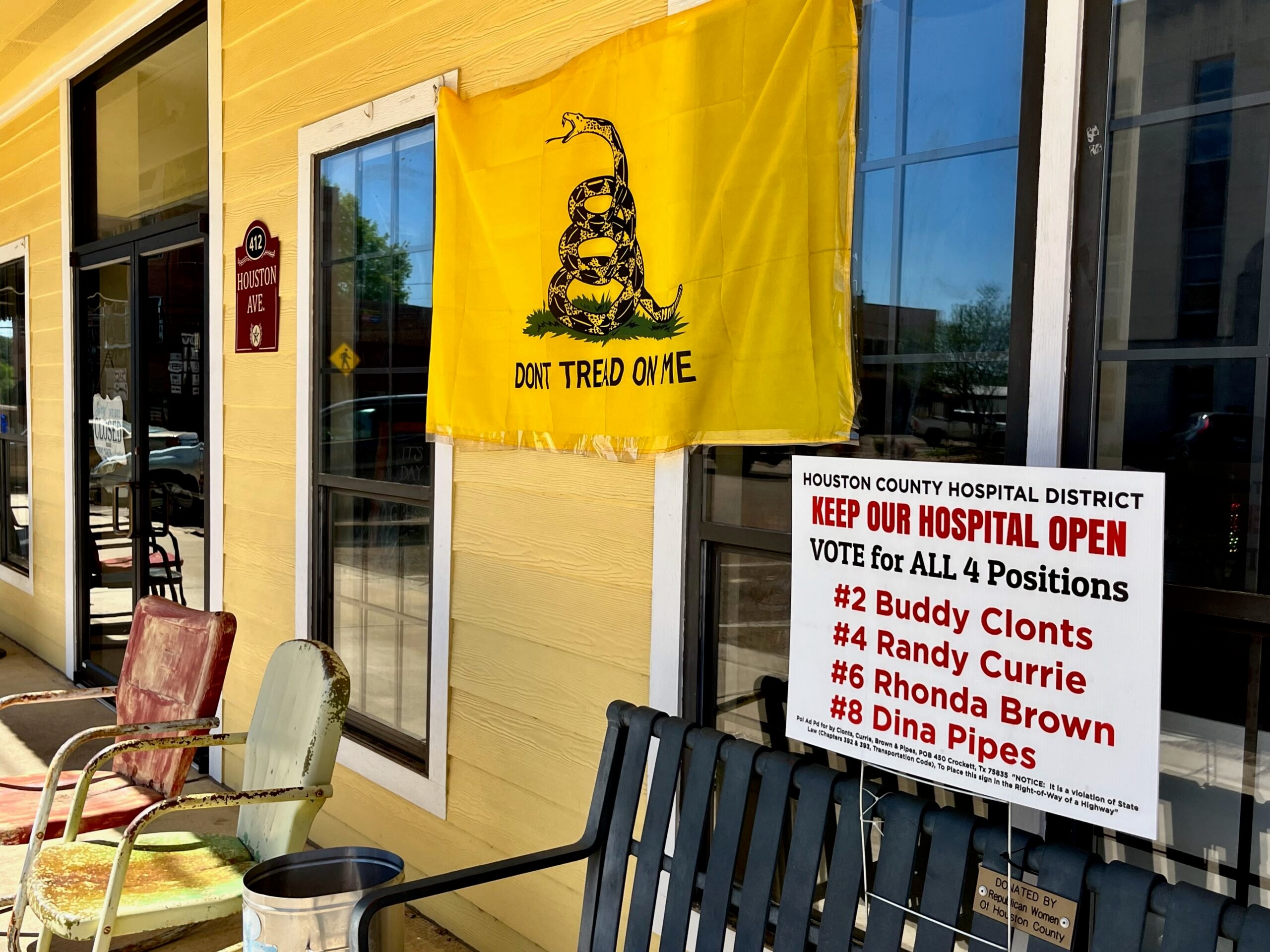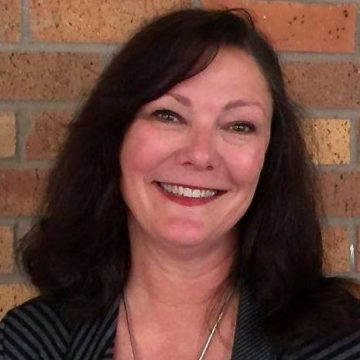This story is part of “The Holdouts,” a collaborative project led by Public Health Watch that focuses on the 10 states that have not expanded Medicaid.
The dueling election signs beckoning voters to choose their next hospital district board have popped up in yards, on street corners, and in the windows of businesses across the small East Texas town of Crockett.
“Keep Our Hospital Open,” reads a large sign with four hospital board candidates’ names emblazoned in red in front of the Moosehead Café on the Houston County courthouse square. Next door, a smaller blue sign imploring people to “Keep a Strong Hospital” lists four other names—the opposing slate.
Elsewhere in Texas, voters are heading to the May 4 polls to choose everything from city council members to school board members. But in this town of about 6,300 residents, the hot local race is over who will govern the future of the only hospital in the county: Mid Coast Medical Center-Crockett.
In the last decade, the hospital—which has had different names—has closed, reopened, and changed operators several times. Now it’s facing financial pressures, including wrestling with costs from treating patients who cannot or will not pay their bills.
Houston County’s struggle to keep its hospital open reflects similar challenges faced by rural hospitals across the state. Texas not only has the highest rate of uninsured residents in the nation, it also has the highest number of rural hospital closures—26 as of 2023, according to an analysis by Chartis, a healthcare advisory firm. In the 10 states that haven’t expanded Medicaid coverage, including Texas, more than half of the rural hospitals are operating in the red, the study found.
Many rural hospitals like Crockett’s encounter resistance to raising local property taxes to keep up with rising costs. They don’t have as much leverage as larger facilities in bigger communities when negotiating reimbursement rates with insurers. Their demographics often make supporting a local hospital more difficult.
“You’re talking about a population that’s older, poorer, sicker, and less insured,” said John Henderson, president and CEO of the Texas Organization of Rural & Community Hospitals.
Crockett, Houston County’s largest town, and the county as a whole have seen their populations decline since 2000. Almost a fifth of the population in Crockett, and 23 percent of the county, is 65 and older, compared with 13 percent for Texas. More than a fifth of Crockett residents under age 65 are uninsured, compared with 18.9 percent statewide for 2022. The poverty rate of 27.3 percent is almost double the 14 percent rate for Texas. Only 14.8 percent of county residents age 25 and over hold a bachelor’s degree or higher, less than half the statewide rate of 32.3 percent.
Barbara Crowson, the current hospital district board president, who is not up for reelection, points to another challenge in supporting the 25-bed hospital in Crockett: geography.
“We’re a very large county and if you live at the southern end, they’re closer to Huntsville than they are to Crockett,” Crowson said. “On the other [eastern] end of the county, they’re closer to Lufkin. They’re not going to drive to Crockett” to go to the hospital when cities closer to them have medical centers.
Most of the hospital’s patients come from the Crockett area or the Houston County Lake area to the north, she said.
The hospital’s fate resonates with many people in this town, named for Davy Crockett, the frontiersman and congressman who died defending the Alamo. Houston County is the oldest county in Texas, established when the state won its independence from Mexico and named after the Republic of Texas’ president, Sam Houston.
In recent years, residents have packed some hospital board meetings. Critics have disrupted meetings, refusing to sit down. The meetings became so contentious that the board proposed and clashed over a “code of conduct” for its own members and the public.
As property values have risen, some people have demanded that the district lower their tax rates, which the board did in a divided vote in 2023, from 13 cents to 10.7 cents per $100 of valuation. The hospital board itself is split between those who want to support the hospital by raising property taxes if necessary to cover costs and expand services and those who say it’s not needed. Tax opponents say the hospital’s operator, Mid Coast Health System, a nonprofit chain based in El Campo, southwest of Houston, receives enough public funds.
“Houston County definitely is not completely unique, but it has a historically torn district on really understanding what all it takes for a small rural hospital to stay viable,” said Brett Kirkham, Mid Coast Health System’s chief executive.
Part of the dissension may stem from Crockett’s rocky history with previous operators that leased the county-owned hospital. East Texas Medical Center, based in Tyler, operated it for about 15 years, then cut back on satellite hospitals and ended its lease in 2015. The county hospital district and the Community Hospital Corporation took over managing the facility temporarily.

The county thought it found a partner when Timberlands Healthcare, a subsidiary of Little River Healthcare based in Rockdale, entered into a lease agreement in early 2016. But Timberlands ran into financial problems and told the board that it had to stop delivering babies. In June 2017, Timberlands closed abruptly, putting almost 200 employees out of work. Patients arriving at the hospital found a sign taped to the front door that read, “Hospital Closed,” with no explanation. Patients had to call 911 in the event of an emergency or travel 35 miles to the nearest hospital in Palestine.
A year later, Little River filed for Chapter 11 bankruptcy, then sought to liquidate its holdings, which included medical facilities in Cameron, Rockdale, and elsewhere in Central Texas. Little River was the target of a U.S. Justice Department investigation that contended it funneled payments to Texas doctors in exchange for referrals for laboratory tests from Little River and two other companies. In June 2022, the department said 15 Texas doctors agreed to pay $2.8 million to settle the kickback allegations.
After Timberlands’ closure, hospital district board members worked to bring in new operators to take over the empty space and lease the facility. A pair of Austin-area doctors reopened the hospital in July 2018 as Crockett Medical Center LLC. It operated on a smaller scale than Timberlands, with an emergency department and 25 inpatient beds.
Crockett attracted attention as one of only a handful of communities in Texas that had a local hospital close and reopen.
“That’s about unprecedented,” said Henderson, of the rural community hospitals group.
Indeed, it was such a rare occurrence that KFF Health News did a long story about it. TV stations and other media also covered the reopening.
Crockett Medical Center seemed to be going strong. Then one of the partner doctors left. The remaining partner decided to return to Austin for personal and professional reasons and informed Crowson that he wouldn’t renew the lease.
“It was a huge shock,” Crowson said.
In 2023, Mid Coast Health System took over the lease. The nonprofit also operates hospitals in El Campo, Palacios, Llano, Bellville, and, most recently, Trinity, about 30 miles from Crockett in adjacent Trinity County. That facility, which had closed seven years earlier, also joined the short list of shuttered hospitals that reopened. Mid Coast held a ribbon-cutting ceremony at the Trinity hospital earlier this month.
Kirkham, the CEO at Mid Coast, said the corporation has tried to find the right formula to keep rural hospitals afloat, sharing costs as much as possible among its six hospitals.
It’s worked well, he said. “But still you have to have the community support. Most of our facilities have a hospital district with some tax support for indigent uncompensated care. But none of that even covers the full burden. … That’s where us being able to pull out cost, to get better contracts, helps give these hospitals a fighting chance.”
One of Mid Coast-Crockett hospital’s advantages is that it’s designated as a “critical access” facility by the federal Centers for Medicare & Medicaid Services. That means the hospital provides 24/7 emergency care and receives cost-based reimbursements for Medicare patients, among other benefits.
Kirkham envisions synergies between Crockett’s and Trinity’s hospitals.
“We can further our mission of keeping expenses down, sharing leadership, flexing staff between both facilities,” Kirkham said. “But it still relies on district support and our communities supporting and wanting and using the hospital locally.”
Kent Waters, the Crockett hospital’s administrator, said he sees that support after one year in the community. The hospital averages about 800 emergency room visits a month and has begun a “swing bed” program that’s paying off. Patients who go to larger hospitals in Lufkin and Palestine for surgery, for example, can come back and receive rehab and nursing in Crockett’s hospital instead of in a skilled nursing facility.
Medicare Advantage plans, which are offered by private insurers, are cutting into that, though, because they tend to reimburse less than traditional Medicare, according to the Chartis study. Kirkham said Advantage plans dilute a key benefit of critical-access programs by increasing rural hospitals’ financial risks with lower reimbursement rates and, at times, slow repayment. “We’re seeing about 55 days to get a claim paid” under Medicare Advantage programs, Kirkham said. He cited an “egregious” case where it took seven months to get the payment.
Insurance trade groups, like AHIP, say Advantage plans provide better services and access to care at a lower cost.
“Right now we need a hospital more than ever.”
As far as Medicaid expansion goes, “We know that’s a very touchy topic in Texas, but for most hospitals it definitely would mean a lot” by increasing the number of paying patients, Kirkham said. A Texas A&M University study released in 2020 found that nearly a million newly eligible Texans would sign up for Medicaid if the program were expanded.
On the other hand, hospitals like Mid Coast-Crocket might still have to deal with Texas’s low Medicaid reimbursements, which don’t cover all the costs, Kirkham said.
Currently, the hospital district board provides $225,000 to the hospital each month; $100,000 is returned to the district for the hospital lease payment. That means a net of $125,000 is used for indigent care costs, Waters said. But actual costs vary and have run as high as $400,000, he said.
During the last cold and flu season, the ER experienced one of its busiest weeks, Waters said. Some people visited for problems better treated by their doctor or by themselves.
“The other day someone came in and it was like they had touched a pan that was a little bit too hot,” Waters said. “A Band-Aid at home probably could have sufficed.”
With all the forms of unpaid care, “That’s why most hospitals still rely on a healthy tax base,” Kirkham said.
Inside the Moosehead Café on a recent Monday morning, diners sat in booths with checkered tablecloths and sipped coffee. The café attracts many locals and visitors from all over Texas and the nation, thanks to its collection of animal heads—including, yes, moose heads—vintage souvenirs, political signs, and its funky, laid-back Texas feel.
Hospital board candidate Buddy Conts, the café’s co-owner, sat at a table with board incumbents Rhonda Brown and Dina Pipes, who are seeking reelection. They want to keep the hospital open but push for more transparency and oversight.
“We aren’t negative,” Brown said. “We want to see this hospital open, prosper, and serve this community.” The candidates said they know the hospital must provide indigent care, but they want more information about where non-paying patients are coming from and how tax dollars are being spent.
“I grew up poor. I know what it’s like to struggle,” Brown said. “I am not against helping people by any means.” But Mid Coast is required by contract to give more financial information—how every dime is being spent, she said. “That’s our job.”
Waters responded that the company gives the board monthly reports on the hospital’s operating condition, as well as a monthly uncompensated-care report. “[We have] done all that we can to get them the information they want without violating any HIPPA concerns” regarding medical privacy, he said.
The opposing slate of candidates aligned with Crowson—the current board president—includes Robert Grier, who has a doctorate in human genetics and biochemistry and was a past board president, and Jarvis McElhany, a 26-year-old paramedic at Houston County EMS. McElhany said he’s seen firsthand the need for the local hospital.
“We have quite a lot of cardiac arrests,” he said. “It’s very hard to do CPR in a helicopter, so we’re going to take them (by ambulance) to the closest facility, which nine out of 10 times is Crockett.
“Right now we need a hospital more than ever.”
McElhany said he’s concerned that “a lot of bickering and needless fighting” will drive the hospital’s operator away.
Crowson, Grier, and McElhany said they favor raising the tax rate to 12 cents per $100 of valuation. The new funds could be used to start a diabetic clinic and attract at least one new doctor to town, they said.
Brown, the current board member who is seeking reelection on the opposing slate, said raising the hospital tax rate is not necessary “because we are meeting all our obligations with sufficient funds.”
Whether enough taxes and other revenue can be squeezed out of a poverty-stricken, underinsured county to keep a hospital afloat is the question many rural hospitals and taxing districts are grappling with these days. Kirkham said it all boils down to community support.
“We’re appreciative of the support we get, but if we’re not wanted here, we can spend our time and efforts in other communities,” he said. “It’s a sad thing, but that’s the reality.”



